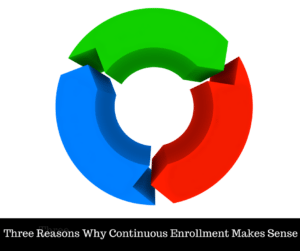Three Reasons Why Continuous Enrollment Makes Sense

Re-enrollment has never made sense to me.
I remember when I was head of school. January rolled around and it was re-enrollment time. Our team spent hours discussing the communication strategy and brainstorming innovative ways that we could encourage families to re-enroll for the next school year.
It was a time-consuming process to develop and implement the strategy. Then, after the re-enrollment time period was completed, we had to divide the list of non-re-enrolled families to contact them. We spent hours chasing after families who did not re-enroll by our deadline.
This is the typical situation that I find in most schools.
Why do we go through this re-enrollment process every year?
Why do we place doubt in our parents’ minds by asking them if they are planning to return for another year?
Why do we make parents jump through the same hoops every year just to tell us that they are returning?
Can anyone tell me why this strategy makes sense?
Five years ago I was introduced to the concept of automatic re-enrollment at Immanuel Christian School in Springfield, VA. I had just started to work with their team and discovered that instead of asking families to re-enroll every year, parents were automatically re-enrolled for the following year by a specified date. Three years ago I wrote a blog post on their experiences in a Q&A format: Automatic Re-Enrollment — Could This Strategy Work at your School?
Parent didn’t have to do anything to enroll for the next year (well. they still had to pay their bill!). All parents were automatically re-enrolled by a certain date and billed accordingly. If the parent decided not to continue their enrollment, then they would have to opt out by telling the school personnel that they were not returning.
Three years ago I began working with Cascade Christian Schools in Puyallup, WA. Instead of re-enrolling families, their strategy focused on Continuous Enrollment. Essentially, their philosophy is that “once enrolled, always enrolled.” The parent is always enrolled until the parent decides to opt-out or the school leadership makes this decision regarding the family. Their process is outlined in detail on their website. I also interviewed Cascade’s Superintendent, Don Johnson, in a blog post last year on retention and he referred to Continuous Enrollment as a key strategy.
Last year, Eastern Christian School in North Haledon, NJ, moved away from re-enrollment and introduced “Continuous Enrollment.” Rudi Gesch, Director of Enrollment and Marketing, modeled their program after Cascade Christian. In addition, to help with communication, they produced an animated video to introduce the concept to their parents. I love the reference to this “Set it and Forget It” model of enrollment in the video.
Just last week, while I was conducting a site visit at Heritage Christian School in Indianapolis, I discovered that they had implemented automatic re-enrollment several years ago with great success.
In 2015, Sara Nordhoff and Mary Braun shared how they moved away from re-enrollment to “assumed enrollment” with great success at the Catlin Gabel School. This webinar, Re-Examining Re-Enrollment, was presented as part of the series offered by the Enrollment Management Association (formerly SSATB).
ISM also published an article in 2014 asking the question: “Perpetual Enrollment — Is it Right for your School?”
I have also heard other school leaders and admissions organizations discussing perpetual or evergreen contracts. However, my preference is to use the term Continuous Enrollment.
In every one of these schools, the following three reasons stand out as to why they moved away from an annual re-enrollment process.
- Opt-Out Instead of Opt-In – By moving to continuous or automatic enrollment, the decision to opt-out is placed on the parent. Re-enrollment asks the parent to opt-in every year while continuous enrollment eliminates the opt-in and focuses on those that opt-out.
- Easier, Simplified Process – Instead of asking parents to complete an annual process, moving to continuous enrollment eliminated unnecessary paperwork and steps required by the parent. The only paperwork required was from the parent choosing to opt-out. Continuous Enrollment saves time and work among the staff.
- Positive Messaging – Asking parents every year at their school if their parents are going to re-enroll their child, creates doubt and a negative buzz among parents and students. Continuous enrollment communicates this positive message and reinforces the value that every child remains enrolled until graduation.
Continuous Enrollment makes sense to me. I have seen it work effectively in these schools. While it won’t be a magical solution to improve your retention rate, it will help improve your enrollment process with your current families.
Is Continuous Enrollment right for your school?
